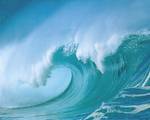A stunning series of satellite imagery of Australia’s Great Barrier Reef released by the CSIRO shows for the first time visual confirmation of the theory that sediment plumes travel to the outer reef, and beyond.
The remotely sensed images, taken from February 9 to 13 this year, challenge conventional thought that sediment travelling from our river systems into the GBR is captured by the longshore current and travels no more than 10 to 15km offshore, affecting only the inner Great Barrier Reef Lagoon and the inner reef corals.
Images captured by CSIRO show large plumes of terrestrial material following unconventional patterns and travelling quite fast as far as 65 to 130km, to the outer reef and, in some instances, travelling along the outer reef and re-entering the reef.
The plumes are the result of heavy rainfalls in northern QLD around late January to early February 2007, with the resulting flood waters carrying a larger sediment load than during regular rainfall and river flow. As such floods have not occurred for a while the accumulated material in the creeks ands rivers coupled with increased sediment runoff from the land is causing a significant transport of terrestrial material to all areas of the affected reefs and reef waters.
Managers of the GBR have long been examining the effects of run-off of sediments, including pesticides, herbicides and fertilizers, on the reef corals.
The images challenge the traditional school of hydrological modelling, which says sediment plume movement in the mid to northern GBR usually go north and never directly flow to the outer reef is spared the direct effects of such river floods.
“A re-think is needed now that we know where flood plumes go,” says CSIRO scientist Arnold Dekker, ”and what this means as organic micropollutants may be travelling to parts of the reef scientists hadn’t thought to look before.”
The images were taken from NASA’s MODIS satellite by GeoScience Australia’s Alice Springs site for a new product being developed by the Wealth from Oceans Flagship to track coastal and ocean events in real-time, building on the technology behind the successful SENTINEL bushfire tracking system.
While extreme coastal events have been captured by remote sensing before, this is the first time they can be seen and analysed straight after the event as there are now more satellites imaging the Earth and CSIRO has invested in fast information delivery systems.
by CSIRO
Link:
http://www.ocean.com/article.asp?locationid=1&resourceid=7661&ProdId=&CatId=1&TabID=&SubTabID=
skip to main |
skip to sidebar

Natures Marvels

Natures Marvels
Blog Archive
-
▼
2007
(38)
-
▼
March
(17)
- Ancient Hurricanes
- Heading for Troubled Waters?
- The Fisheries Museum in Lunenbourg
- Some Of the Weird Species Found Recently In New Ze...
- Fangtooth and his Friends
- Hypoxia in the Gulf of Mexico
- Weapons-Grade Uranium
- Russia Building Floating Nuclear Power Plant
- Great White Shark
- Great Barrier Reef Down River
- Hammerhead Sharks- Are They Misunderstood ?
- Check Out This Wave
- How Important Are Tiny Krill To Ocean Turbulence
- Don't We Wish All Kids Were This Passionate About ...
- Shark Discoveries In Indonesia
- Shark Water- How Biased Is It
- Basking Sharks- Deep Sea Monsters?
-
▼
March
(17)
No comments:
Post a Comment